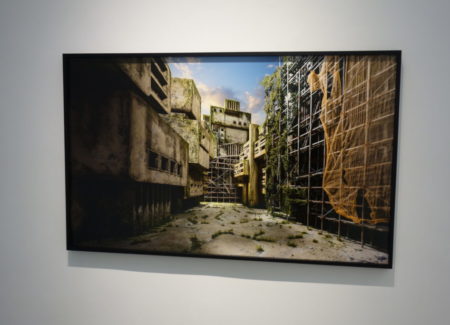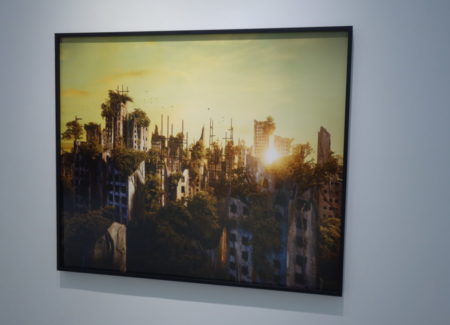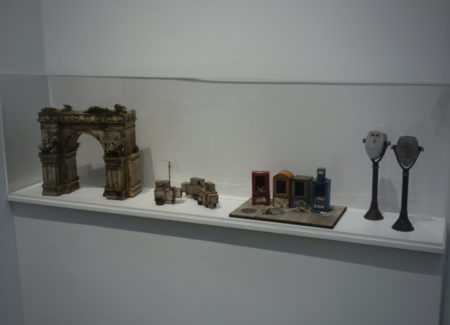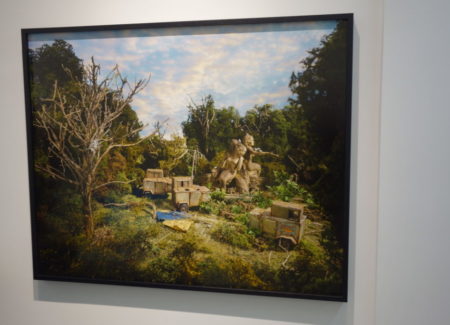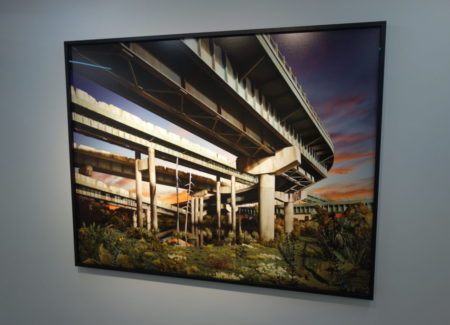JTF (just the facts): A total of 9 large scale photographs, framed in black and unmatted, and hung against white walls in the main gallery space and behind the reception desk. All of the works are archival pigment prints, made between 2015 and 2017. The works on view range in size from roughly 40×40 to 70×48 inches (or reverse), and the prints are available in total editions of 15. The show also includes a vitrine with several of the original elements from the diorama constructions. (Installation shots below.)
Comments/Context: If we are willing to take a clear-eyed look at the history of once prosperous and powerful human empires, what we find today is largely ancient ruins. Whether we choose to examine the Incas or the Mayans, the Greeks or the Romans, or any number of other dominant peoples, what visibly and durably remains of their vast and complex civilizations is often their grand and impermeable stone architecture, albeit fallen into disrepair and often reclaimed by nature. Time wipes away ephemeral traces quite quickly, but the rocks tend not to move without the help of cataclysmic events.
So when futurists look ahead to the perhaps inevitable fall of our current civilization, the structure of their imaginings usually takes its cues from the past. Apocalyptic scenarios of various kinds (nuclear war, climate disaster, pandemic disease, etc.) tend to be decorated by our optimistic steel skyscrapers and concrete highways left abandoned and nature doing what it always does, slowly and patiently recolonizing urban cities and undoing man-made realities, with trees poking through sidewalks and broken windows and ivy climbing unforgiving walls.
Starting back in 2005, Lori Nix and Kathleen Gerber began working on a decade-long project called The City, which envisioned a series of ruined interiors that captured this ominous sense of the world gone astray. Using meticulously hand-crafted dioramas (not unlike miniature stage sets), they showed us broken libraries, empty laundromats, rotting casinos, a junked take out Chinese food joint, and even a sand filled subway car, each scene rattlingly quiet and void of any kind of human presence.
In their newest pictures, the two have left the confines of their grubbily destroyed interior spaces and stepped out into the freshness of the open air, crafting city- and landscapes that imagine the decay of the world on a somewhat wider scale. Moving closer to the dark ennui of James Casebere’s suburban towns and villages (some of which were on fire), Nix and Gerber envision stylized places we might plausibly recognize, only they’ve been rudely upended by the perilous fall into failure, disintegration, and ongoing decline.
The most urban of Nix and Gerber’s constructions are filled with clustered streets of multi-story buildings that look reminiscent of New York. In Utopia, the scene looks more like a bombed out war zone, with construction stopped and scaffolding left in place when the action began; now the street echoes with emptiness, the concrete interrupted by weeds and the mold-covered forms awash in soot and grime. In Rift, a yawning chasm has opened at the foot of a building that looks a little like the Flatiron, the sinkhole falling down through layers of dirt and rock to an indeterminate bottom and threatening to draw more empty buildings into its gawping mouth. In Sentinel, the blown out newspaper boxes echo the dark rows of windows in the vacant buildings behind, the gloomy “It’s Over” headline of a leftover paper tossing one last jab at the powers that once were. And in Dawn, a new morning seems to have come, the skyline of the city overgrown and unruly like the setting of Jeff VanderMeer’s Borne, but perhaps warmed by a hint of optimism that lies amid the encroaching spoilage and disrepair.
Nix and Gerber also seem to have influenced by the colors found in the skies of the Hudson River School painters, as many of their otherwise crumbling scenes are enlivened by pastel skies. A salmon pink and orange sunset settles over a city park, its triumphant stone arch now flooded and covered with greenery. Similar bright red and pinks dot the sky above a tangle of concrete overpasses, the underneath area returning to a bog-like jungle that would happily house dinosaurs. And another leafy park scene centered on a fountain of stone sirens is decorated by rusting metal food carts, a dead tree, and the puffy whiteness of dappled clouds.
The two other works in the show (Fall Monument and Winter Monument) seemed to me to be drawn straight from recent news headlines. The paired images depict a rocky western national park (not unlike the Grand Canyon) left to rot, the lonely coin-operated telescopes rusted and toppled over. Even though Nix and Gerber made the images before the Trump administration reduced the size of two major parks in Utah, their sad viewing stands and whispering snow cover feel like just the kind of details that might be actually be real now that we have stepped back from protecting such lands.
While I’m not certain whether Nix and Gerber deliberately meant their new series to match the mood of the moment, their intricate end of times fabrications might well resonate mightily with those who feel we have temporarily lost our collective way. Their scenes seem to silently remind us that any number of missteps or bad choices could be the beginning of the end, inexorably leading to versions of the plausibly dark outcomes pictured here.
Collector’s POV: The prints in this show are priced at either $6000 or $7000, based on size. The work of Nix/Gerber has little secondary market history at this point, so gallery retail likely remains the best option for those collectors interested in following up.

